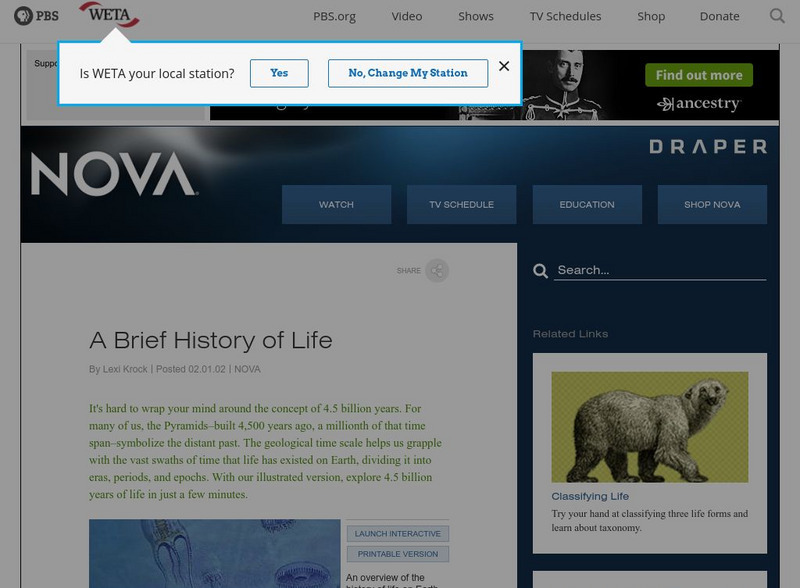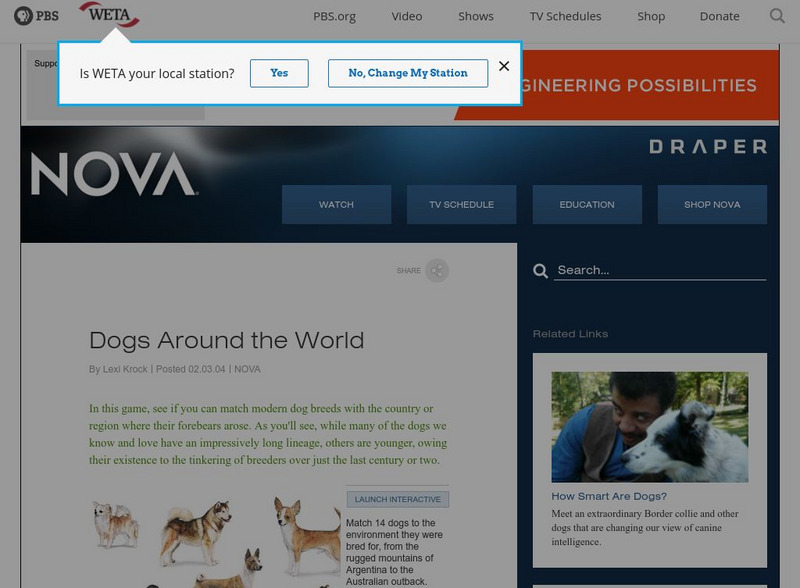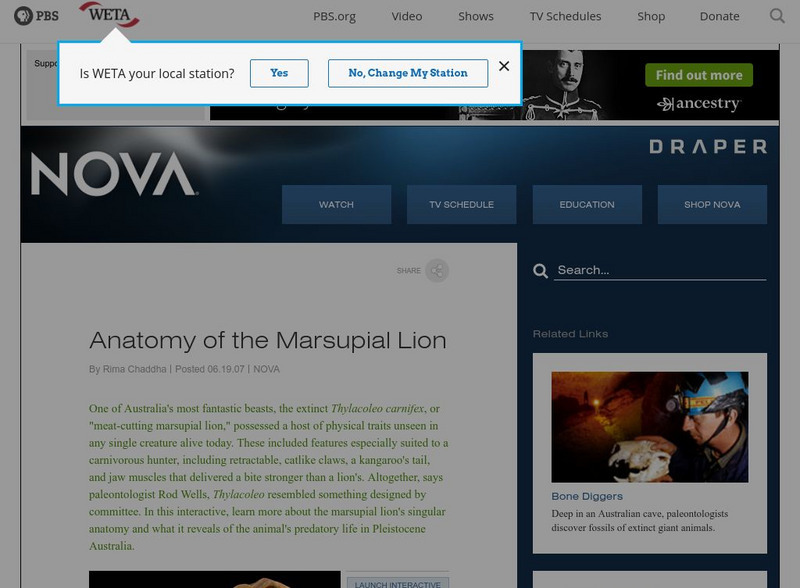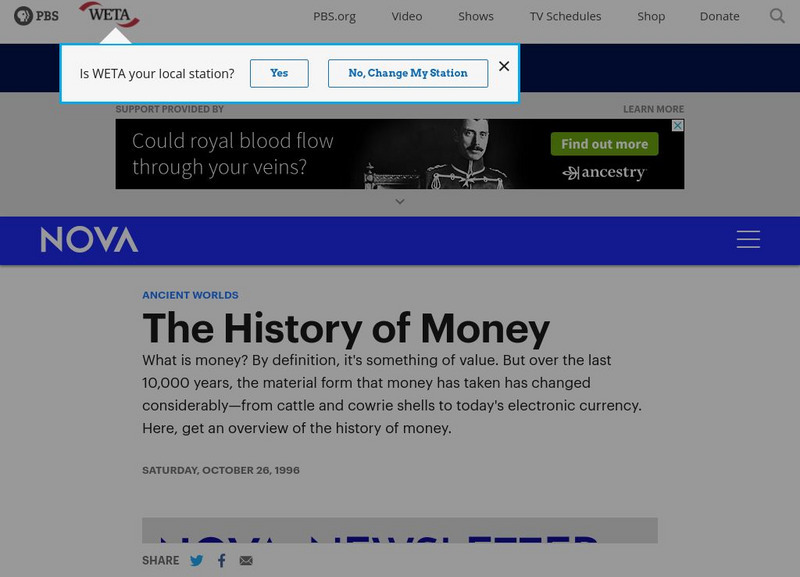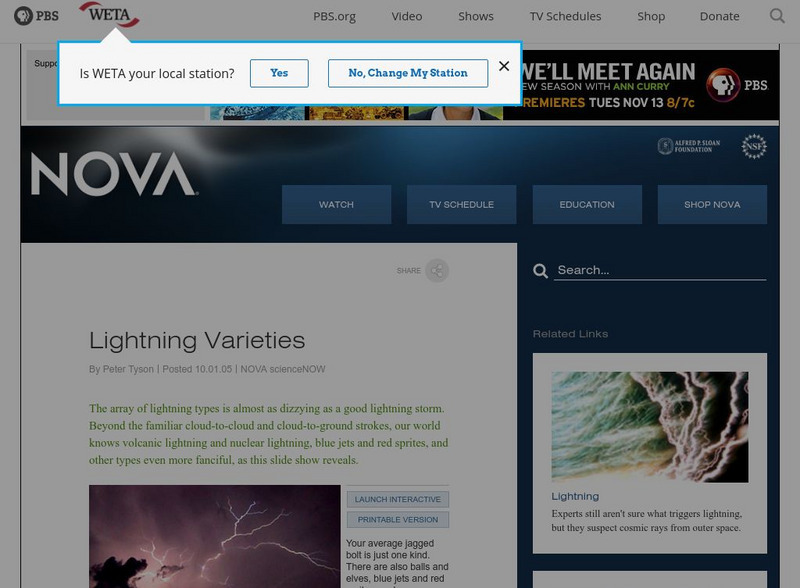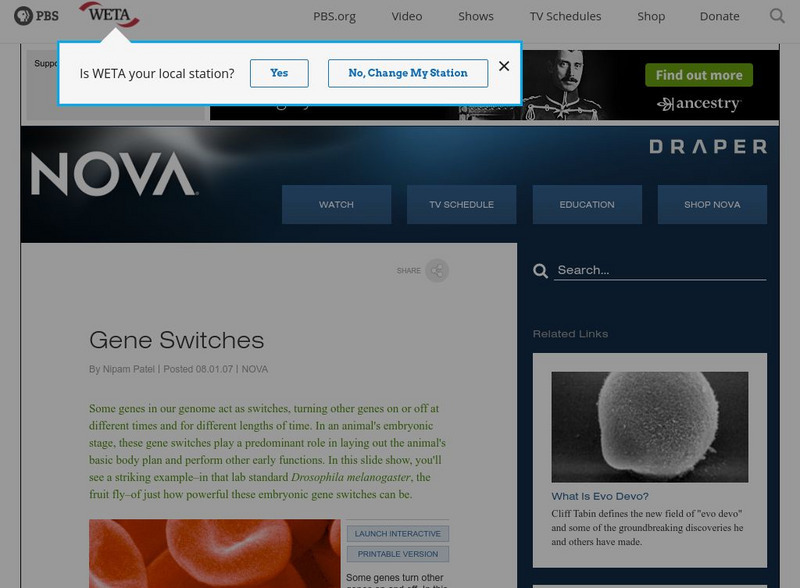PBS
Pbs Teachers: Supersonic Dream: Anatomy of Concorde
Examine the features of Concorde that were designed and engineered for high-altitude, supersonic flight by exploring this detailed, interactive cross section.
PBS
Pbs Teachers: Nova: Kaboom! Pyrotechnics: It's Elemental
Describe The Periodic Table of Elements, identify the elements that make a firework work and examine the contribution of each element to the total fireworks effect.
PBS
Pbs Orchid Hunter: Orchid Gallery
NOVA presents a slide show of orchids with brief descriptions of each of the 15 pictures. See the beauty of each orchid, who it was named for and where it lives.
PBS
Pbs Nova: The Big Energy Gamble
While most people believe that global warming is a reality, Marlo Lewis, Jr. is a skeptic. Lewis is with the Competitive Enterprise Institute in Washington, D.C. In this interview, he questions the California initiative to lower...
PBS
Nova: The Big Chill
Explore some of the explanations for the ice ages that have occurred in the Earth's history. The explanations are all related to conditions caused by plate tectonics.
PBS
Nova: The Seven Summits
View a slide show of the seven tallest peaks found on seven different continents. An interactive map will show you the location of each of the mountains. You can also get information on elevation, the name's meaning, and the first people...
PBS
Nova: Picturing the Molecules of Life
Retrace the development of our knowledge of nucleic acids by viewing pictures of nucleic acids (both DNA and RNA) taken in 1952, 1973, 1979, 1980, 1984 and 2001.
PBS
Pbs Nova: Secrets of the Parthenon: Scenes From a Marble Quarry
Learn about the tools and technologies that Greek stonemasons used to cut and shape blocks of marble destined for the Parthenon. Also learn about how the stone was transported to the building site and set into place.
PBS
Nova: The Iceman's Last Meal
Wonder what the iceman ate just hours before he died. This site tells you and explains how the scientist came to figure this out. Includes photos.
PBS
Nova: Bitten by the Bug
Peter Tyson explains the reasons he finds amber fossils so interesting. Read his descriptions and catch his passion for these fossils.
PBS
Nova: Amber Around the World
Using an interactive map, find out where amber fossils are located around the world. Twelve different locations are represented on the map.
PBS
Nova: A Brief History of Earth
This timeline is a good resource if you are looking for brief descriptions of the geologic periods. Descriptions include pictures of common organisms for each period and the range of time covered by each period.
PBS
Nova: Scientists Finally Study Kennewick Man
News article relating the history of Kennewick Man and the expectations of scientific analysis of the remains. Links offer additional news releases regarding legal issues preventing research.
PBS
Nova: Gallery of Auroras
Find out what causes the aurora borealis. You can view some interesting photographs of the aurora in action.
PBS
Nova: Dogs Around the World
Play an interactive game where you can match modern dog breeds with the country in which they originated.
PBS
Nova: Bone Diggers: Anatomy of Thylacoleo
Thylacoleo or the extinct marsupial lion had an unusual array of adaptations that enabled it to be an effective predator. Explore an interactive fossil of the lion to learn more about each of its' adaptations.
PBS
Nova: How Low Can You Go?
After introducing you to the cascade process for reaching absolute zero, this interactive will challenge you to choose the right combination of gases to liquify oxygen.
PBS
Nova Online: History of Money
A timeline of money from 9000 B.C. to the present day that explains the types of money being used at various times in history.
PBS
Pbs Teachers: Welcome to Mars: Mars Up Close Spirit and Opportunity
Take an interactive, narrated tour through some of the most stunning and outlandish images and data sent back by the two Mars rovers Spirit and Opportunity. Consider the many reasons why scientists are certain that Mars had a wet past.
PBS
Pbs Teachers: Nova Science Now Lightning: Lightning Varieties
Compare and contrast different types of lightning bolts. A substantial amount of information is provided here including pictures with descriptions for each type of lightning bolt. NOTE: The interactive is no longer available; Click on...
PBS
Pbs Nova: Gene Switches
Colorful, easy-to-understand slideshow on gene switches. These embryonic gene switches play a powerful, predominant role in the animal's basic body plan and other early functions. 8/1/2007
PBS
Pbs: Nova: Timeline: The Pursuit of Immortality
A timeline that allows students to explore humans' pursuit of a longer and healthier life. Includes major events from fourteenth through the twentieth centuries.
PBS
Pbs: Nova: Body and Brain: Anatomy of Childbirth
A look at three stages of childbirth--active labor, delivery, and post-delivery--complete with simple diagrams as well as notes on related risks, including fistulas and excessive bleeding, and treatments.
PBS
Nova Online: How Many Pearls? A Weight & Volume Game
This interactive game has students apply skills in estimation, measurement, and basic addition using pearls. Students are asked to estimate the number of pearls in a treasure chest by making predictions and using number sense. The skills...













